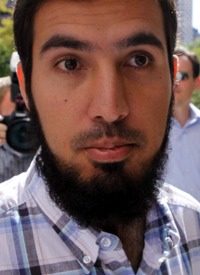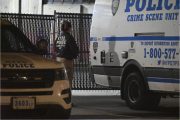
The Center for Strategic International Studies (CSIS) recently published a report entitled “A Growing Terrorist Threat? Assessing ‘Homegrown’ Extremism in the United States.” The report was co-authored by Rick Nelson and Ben Bodurian. The title effectively summarizes the thesis addressed in the study’s 14 pages. Nelson and Bodurian examine the cases of five incidences of acts of violence perpetrated by Americans since the autumn of 2009. By spotlighting these particular cases, the authors hope to extricate from the fabric of these tales a common thread and then use that thread in the identification of potential targets of extremist evangelism and prevent any future attacks.
The first case listed in the report is that of Najibullah Zazi, an Afghani citizen and permanent legal resident of the United States who on September 19, 2009 was arrested on suspicion of having aided an American-based al-Qaeda cell in the planning of suicide bombings to be carried out in the New York City subway system. Zazi reportedly received weapons and explosives training at an al-Qaeda camp in Pakistan in 2008. According to testimony, on September 9, 2009, Zazi drove from his home near Denver, Colorado, to New York City in order to detonate explosives on the New York City subway during rush hour. Zazi lost his nerve, however, after being warned by a local imam that U.S. intelligence officials were asking about his whereabouts. In fear, he flew home to Colorado, where he was arrested a few days later. On February 22, 2010, he pled guilty in the United States District Court for the Eastern District of New York to conspiring to use weapons of mass destruction, conspiring to commit murder in a foreign country, and providing material support to a terrorist organization. Sentencing is scheduled to take place on June 25 of this year.The second example of “homegrown terrorism” cited in the study is that of David Coleman Headley. Unlike Zazi, Headley was born in the United States to an American mother and a Pakistani father. When his parents divorced, Headley returned to Pakistan with his father and began attending a military school for boys. When he was 17, however, Headley’s mother flew to Pakistan and took her children back to Philadelphia.On October 27, 2009, federal complaints were unsealed wherein Headley was accused by the Federal Bureau of Investigation of plotting to attack the offices of a newspaper in Copenhagen, Denmark, where a cartoon of the prophet Mohammed was published in September of 2005.In December a second set of charges were filed by the FBI against Headley, accusing him of having given material support to Lashkar-i-Taiba, a militant Pakistani Islamist group in their plot to bomb targets in Mumbai, India, and aiding and abetting the murder of U.S. citizens. There is additional evidence out of India that Headley participated in the bombing of a German bakery in Pune, India, that killed 15 and injured more than 50.The third piece of evidence of America’s burgeoning homegrown terrorist epidemic is that of Major Nidal Malik Hasan, the U.S. Army officer charged with 13 counts of murder and 32 counts of attempted murder for his rampage at an Army processing center at Ft. Hood, Texas. Hasan was born and raised in America to Palestinian parents. For about a year prior to his shooting spree, Hasan was carrying on an e-mail correspondence with Anwar al-Awlaki, a Yemeni-based cleric believed to have inspired several young militants.Currently, Major Hasan is recovering from wounds he suffered when police officers shot him as he fled the scene of the crime. He is awaiting trial by a military tribunal and is expected to assert insanity as a defense against the charges.
Next, less than one month later, federal indictments were unsealed against eight Somali-Americans accused of supporting the terrorist activities of al-Shabaab, a Somali group considered a terror organization by the United States. They allegedly provided financial assistance to others who traveled to Somalia with the intent to fight for al-Shabaab. The U.S. State Department has said al-Shabaab is believed to have ties to al-Qaeda.
Although all have been indicted, as of November 2009, none of the eight was believed to be presently in the United States, and only one is in custody, Mahamud Said Omar, who was arrested and detained in the Netherlands.
The fifth and final case outlined in the report involves five men from Virginia who were arrested on December 9, 2009 in Sargodha, Pakistan, while they met at the home of a man believed belong to a radical jihadist organization. American authorities claim the men had traveled to Pakistan in order to train to fight alongside the Taliban. There is no proof, however, that the men attended any such camp or received any training of the sort of which they are accused. All of the five are U.S. citizens, according to law-enforcement officials in Pakistan and Virginia.
After laying out the five cases cited above, the authors of the CSIS report claim that the men accused of planning and participating in these terroristic plots are especially attractive to the forces of global terrorism because of their citizenship and/or nationality and their ability to more effectively communicate in English and blend in to American society.
This report is not the first time such a threat has been analyzed, however. As early as 2006, the FBI warned against the danger posed by “self-radicalized individuals living in the United States." As a result of that inquiry, Representative Jane Harman (D-Calif.) introduced the “Violent Radicalization and Homegrown Terrorism Act of 2007.” The aim of the bill was to aid the Department of Homeland Security in the detection and prevention of terrorist acts committed by “a group or individual born, raised, or based and operating primarily within the United States or any possession of the United States.” The bill was passed by the House of Representatives, but not by the Senate and thankfully has been declared dead. The Department of Homeland Security already possesses power beyond the bounds of probable cause as set forth in the Fourth Amendment to the Constitution.
Citing articles published in the Washington Post’s journal, Foreign Policy, as well as the online version, ForeignPolicy.com, Nelson and Bodurian suggest that in order to eliminate this pernicious and insidious threat, “local governments must continue … to build strong partnerships with Muslim communities.” This improved interaction, they claim, will come in handy when law enforcement begins searching for accused criminals as they will known just where to go to interrogate “friends and families” of the alleged terrorists.
As most of the “self-radicalization” of these young American Muslims (according to the circumstantial data cited in the study) happens via the Internet through the web-based presence of imams such as the aforementioned Anwar al-Awlaki, the authors recommend that the “national government increase attempts to more closely monitor the internet in order to detect ‘radicalization.’” This unconstitutional enlargement of the federal police power sounds harmless enough to most Americans when the target is “radical” Muslims; however, they might feel less inclined to turn a blind eye to such surveillance if those being watched were “radical” conservatives or others deemed to be enemies of the State.
There is little wonder why the Washington Post and its print and web publications gladly laid down the journalistic cover fire for CSIS’s attack on the freedoms from tyranny guaranteed by the Constitution. The establishment’s own noxious goals are furthered by the deployment and development of a monitoring apparatus that could so readily be redirected from searching for radicals practicing Islam to those “radicals” they find equally abhorrent: gun owners, Christians, constitutionalists, etc.
Photo of Najibullah Zazi: AP Images



